Check out the original blog post on OpenChannels at:
Part 3: Causes and consequences of tipped coral reef ecosystems in Hawai‘i
In our previous blog post, we described some of the key attributes of threshold-based management that have successfully prevented ecosystems from crossing tipping points or have helped restore previously tipped systems. In this blog, we present research from our case study region of Hawai‘i, where many coral reef ecosystems may be nearing critical tipping points, and others have already crossed thresholds into algae-dominated states. Our team of social and ecological researchers is working to highlight the main drivers of change in Hawai‘i’s reef ecosystems and provide marine managers with the information and tools necessary to maintain resilient reefs.
Reefs matter
Coral reefs are among the most biologically diverse ecosystems on earth, harbouring approximately 25% of all marine species. They provide a wide range of crucial ecosystem goods and services, such as food, coastal protection and income from tourism. But, coral reefs around the world are also in danger. Threats such as global warming, ocean acidification, overfishing and pollution have caused reef ecosystems in many parts of the world to “tip” into alternate ecosystem states, often with negative consequences for biodiversity and coastal communities.
These threats underline an urgent need to anticipate and prevent further losses of coral and to reverse shifts in already degraded reefs. Such challenges require a better understanding of the resilience of these complex reef systems and of the human and natural factors threatening them. Our Hawai‘i case study research team—in partnership with key state and federal agencies, non-governmental organizations, and community groups—aims to contribute to a better understanding of how to anticipate, avoid, and respond to ecosystem shifts in Hawai‘i and elsewhere around the world.
Algae, not coral, dominates Hawai‘i’s reefs
Expanding upon previous efforts to synthesize reef data, we have compiled the most comprehensive database of fish and benthic species available for the Hawaiian Islands, from nearly 6000 sites. Using data from 302 of these sites, Jean-Baptiste Jouffray and colleagues developed a new methodology for detecting, visualising and defining multiple reef regimes. They presented their preliminary conclusions in a publication as part of the Nov. 24 special issue of Philosophical Transactions of the Royal Society—Biological Science. The study, led by the Stockholm Resilience Centre, Stanford University’s Center for Ocean Solutions, the University of Hawai‘i, National Oceanic and Atmospheric Association, the Scripps Institute of Oceanography, and Conservation International-Hawai‘i, also identified the key stressors of these reef systems, including declines in herbivorous fish abundance, ocean temperature and pollution run-off from land.
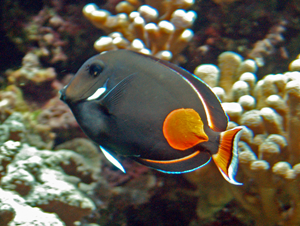
Achilles Tang (or surgeonfish) is a common algae grazer on tropical reefs
While previous scientific debate has largely centered around the shift between coral-dominated reefs and the undesired fleshy algae-dominated reefs, the study unexpectedly revealed that over half of the reefs studied in Hawai‘i belong to a third state dominated by turf algae. Meanwhile, only one-third of the coral reef ecosystems surveyed throughout Hawai‘i were dominated by healthy corals and calcareous algae.
While some algal cover is natural on Hawaiian reefs, the turf algae domination on over half of reefs surveyed raises the question of whether turf-dominated reefs are stable configurations versus transitional states moving either towards macroalgae or coral recovery. Since our recent analysis is only a snapshot in time, time series data showing changes in reefs over a period of time will be necessary to explore this question further.
Grazers, Scrapers, and Browsers—oh my!
Jouffray and colleagues also set out to identify the primary drivers of these three reef regimes (coral, macroalgae, turf algae) by investigating a set of human and biophysical variables (e.g., reef depth and latitude, and proxies for fishing pressure, nutrient runoff, and sediments) that might be impacting reef state. Determining which variables are most likely to have a negative impact on reefs has the potential to provide tangible targets to managers.
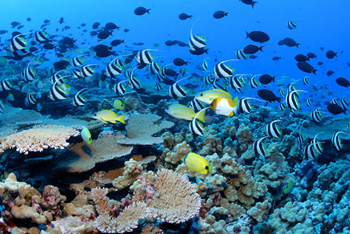
An example of a calcifying reef regime, which is dominated by hard corals
Higher numbers of herbivorous (algae-eating) fish proved to be the strongest indicator of reef state throughout the Hawaiian Islands. The more herbivorous fish found at a study site, the greater the coral cover and the lower the algal presence. However, a deeper dive into the fish distribution data revealed that type of herbivore is also important.
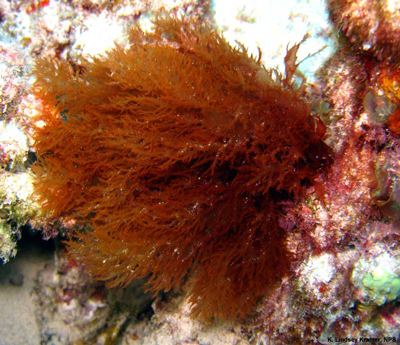
An example turf algae regime
Coral reef herbivorous fish can be categorized into three groups: grazers, scrapers and browsers. The grazers feed on short algal turf much like ungulates crop grass on land, preventing the establishment and growth of larger fleshy macroalgae. Scrapers also eat algal turf, but tend to remove it completely in patches, providing bare areas for coral recruitment. Finally, browsers consistently feed on macroalgae and may play a crucial role in reversing macroalgae-dominated states.
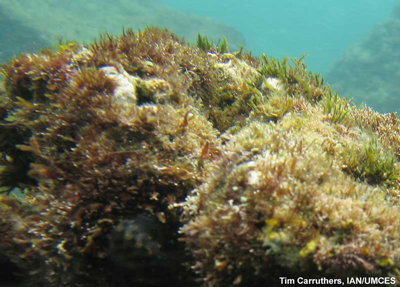
An example macroalgae regime
For management purposes, these data indicate that it is not enough to consider herbivores as a uniform group when managing coral reef ecosystems, since different feeding behaviors by different groups may contribute to different reef states.
Managing multiple stressors on Hawaiian reefs
Sewage and other effluents from human settlements proved to be the second greatest factor in reef decline in Hawai‘i, confirming findings elsewhere. Some of the healthiest corals in Hawai‘i were found in the remote northwestern Hawaiian Islands, where they are effectively conserved as part of the Papahānaumokuākea Marine National Monument. Identifying the healthy, natural condition of coral reefs is important for managers seeking to protect the reefs and the ecosystem services they can generate.
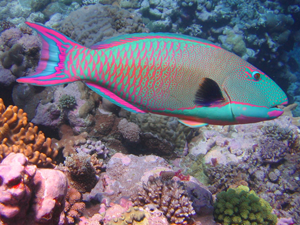
The bi-color parrotfish is an important herbivore on Hawai'i's reefs that scrapes algae off patches of reef, allowing new coral polyps to grow
Our initial research tells us that there are tipping points for coral reefs, where even small increases in human stressors can impart major changes in the status of reefs. From a management perspective, understanding the safe operating space is critical, and these tipping points give us concrete milestones to shoot for to protect healthy reefs, recover reefs that are in decline, and increase the benefits that reefs provide to communities across the Hawaiian archipelago.
Visit our website for the latest updates and more information about our Hawai‘i case study research goals, outputs, and regional partners.
